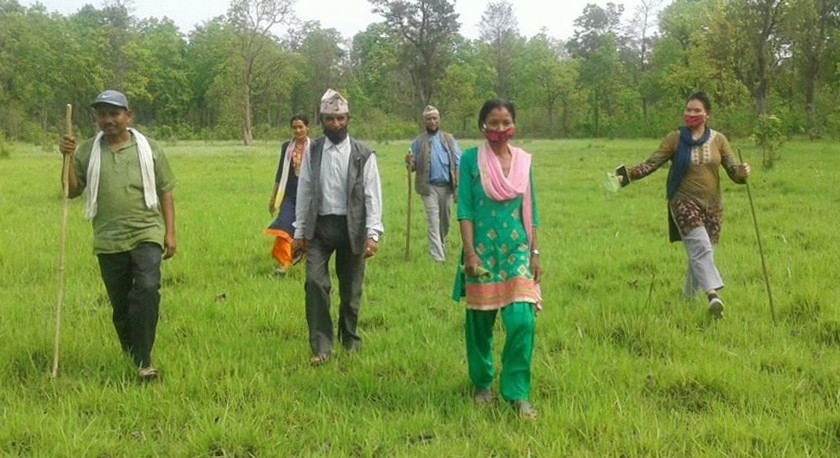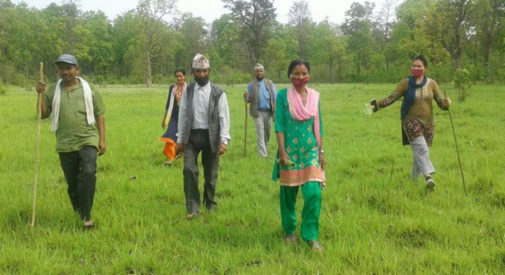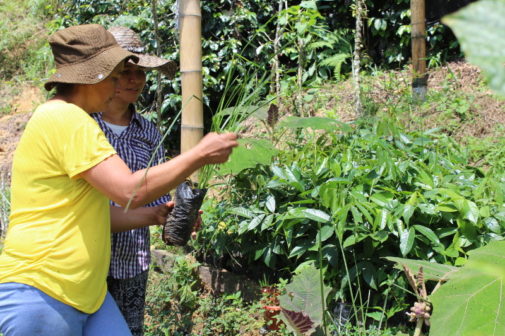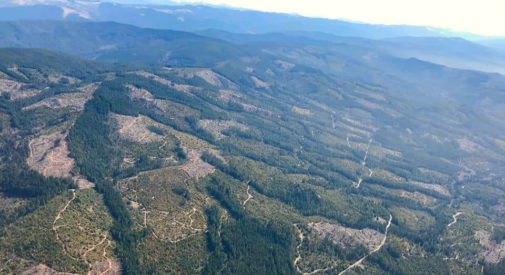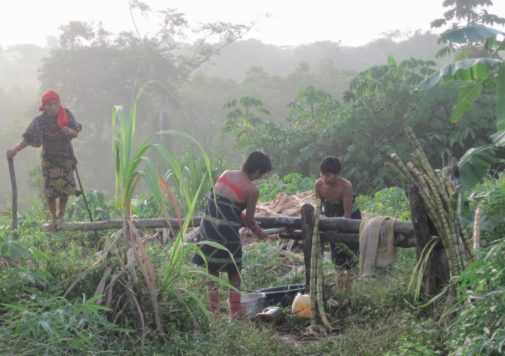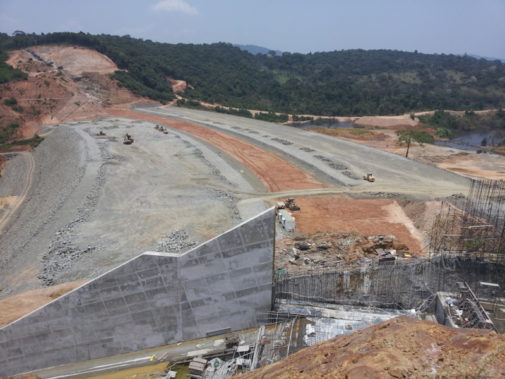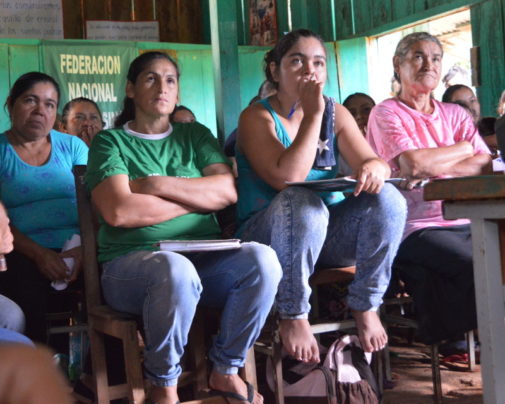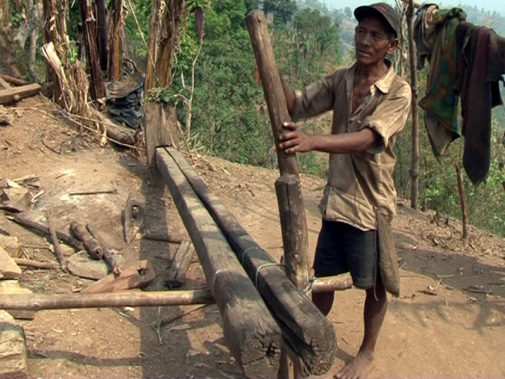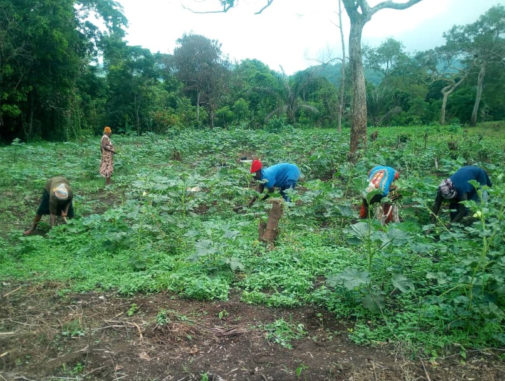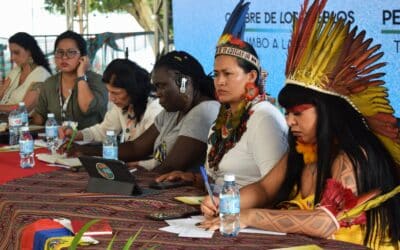May 22nd is the International Day for Biological Diversity and the theme chosen by the United Nations Convention on Biological Diversity (CBD) this year is “Our solutions are in nature”. This is a clear reference to increasingly popular nature-based solutions (NBS) as a strategy for mitigating climate change and biodiversity loss. Unfortunately, NBS as a concept has been twisted by corporations and governments to falsely re-brand highly damaging practices as “green”.
As part of the #OurNatureIsNotYourSolution campaign we’re launching this special edition of our magazine Forest Cover, written in collaboration with our member groups. Forest Cover highlights how hype around NBS is being used as cover for pushing forest offsets, monoculture tree plantations and other false solutions, and also provides examples of the real solutions that our members in Colombia, Ghana, Nepal, Panama, Paraguay and Sri Lanka are engaged in.
Please join us in a social media campaign to oppose false solutions and greenwashing, and to showcase ecosystem-based, community-led and gender-responsive approaches that are of far more benefit to the climate, biodiversity and communities. Our social media pack has everything you need to get involved!
See also analysis by our colleague Ruth Nyambura on the links between NBS and the key findings of the FAO State of the World’s Forests 2020 report, which was published today, and a blog about the links between NBS and geoengineering by our climate campaign coordinator Coraina de la Plaza.
You can download the print version of Forest Cover or read the articles individually below. If you’re not already on it, you can subscribe to our email list to receive future editions of Forest Cover and other GFC publications.
Download the print version in English (web quality 3.6MB | low resolution 0.9MB), en español (web quality | low resolution), en français (web quality | low resolution) and на русском (web quality 3.6MB | low resolution 0.9MB).
Contents:
Editorial: Real solutions are needed to protect people and the planet in an era of global crisis
Old schemes and scams are lurking under the shadow of the “nature-based solutions” umbrella
The women of the Peasant and Community Reserves Collective of Santander, Colombia: A real achievement in protecting land and creating alternatives for buen vivir
California spins nature-based solutions to normalize negative emissions technologies
Solutions based on Nabgwana (Mother Nature)
Large dams in Sri Lanka are a false solution to climate change and water scarcity
The settlement of Crescencio González, a real solution to the current crisis
Drax Plc, pioneering another false solution to the climate emergency
Nepal’s Chepang Indigenous People show how conserving biodiversity and sustainable livelihoods go hand-in-hand
Forest offsets for air travel: the new frontier in nature-based solutions
Women-led solutions to forest degradation in Ghana
Editorial: Real solutions are needed to protect people and the planet in an era of global crisis
By Dil Raj Khanal, FECOFUN and Global Forest Coalition board member, Nepal
The origins of the current global crises we face, such as climate change, biodiversity loss and the COVID-19 pandemic, are deeply rooted in the false solutions championed by governments and the corporate sector that exploit nature and harm its peoples. Mother nature herself is not a source of global crisis, and we have no right to continue to exploit her in the name of finding “solutions” to the crises caused by corporate greed. Real solutions to global environmental crisis must come from the ground up, where governments and corporations commit to supporting transformational change centred on ecosystem-based, community-led and gender-responsive approaches.
Instead, numerous false solutions such as carbon offsetting, emissions trading and negative emissions technologies, many of which fall under the nature-based solutions banner, are being imposed at different levels. They are exploiting nature, harming ecosystems and violating the human rights of Indigenous Peoples, local communities and women.
Part of the problem is the influence that corporations wield over global mechanisms on climate change and biological diversity, such as the United Nations Framework Convention on Climate Change (UNFCCC) and the Convention on Biological Diversity (CBD). For example, the CBD’s theme for this year’s International Day for Biological Diversity is “Our solutions are in nature”. This is a clear attempt to push controversial nature-based solutions (NBS), a term which is increasingly being co-opted by governments and corporations to include false solutions that delay and distract from urgent and real action. In response, this issue of Forest Cover highlights resistance from frontline communities to these false solutions and amplifies the message that “Our nature is not your solution”.
The Intergovernmental Science-Policy Platform on Biodiversity and Ecosystem Services (IPBES) and the Intergovernmental Panel on Climate Change (IPCC) are continuously emphasizing the importance of ecosystem-based approaches (EBA) as real solutions to the climate and biodiversity crises. The Parties to the CBD have also already agreed that real climate solutions related to land and oceans should be ecosystem-based and have developed detailed and meaningful guidance for EBAs, recognizing that they should respect the rights, roles, customary practices and traditional knowledge of Indigenous Peoples, local communities and women.
Embracing new NBS terminology is a way to circumvent this guidance, as it is much broader in scope and leaves the door wide open to many harmful “solutions” such as commercial tree plantations as a forest restoration strategy. It is imperative that the post-2020 Global Biodiversity Framework, the UN Climate Convention and other global policy processes avoid dangerous language around NBS, and instead provide support to real climate and biodiversity solutions that are of benefit to people and the planet.
A number of articles in this issue of Forest Cover highlight the dangers and impacts of corporate-driven false solutions. In Sri Lanka (as in other countries in the region, such as India, Nepal and Bhutan), large dams are being built as a solution to water scarcity that are simultaneously destroying forests and erasing an ancient water system that provided clean water to communities while protecting biodiversity. In California, state legislators are promoting NBS, negative emissions and geoengineering technologies that will have potentially severe land use, water and biodiversity impacts. In the UK, the world’s largest biomass power station is using negative emissions greenwashing to lobby for more subsidies long into the future. Other articles describe how the private sector is turning to forest offsets and commercial tree plantations in order to profit from the climate crisis.
In contrast, we are proud to present several practical and powerful examples of gender-responsive, ecosystem-based and community-led initiatives to mitigate the impacts of climate change and protect ecosystems and biodiversity that our member groups are engaged in at the community level. In the Peasant and Community Reserves of Santander, Colombia, women are leading efforts to build climate resilience and conserve forests. In Panama, the Gunadule are using their Indigenous traditional knowledge to combat climate change. In Paraguay, the settlement of Crescencio González is using women-led self-organizing to overcome the environmental and social crises created by agribusiness. And in Ghana, women’s rights groups are restoring forests and building sustainable livelihoods through organizing for gender equality.
In Nepal, Indigenous Peoples and local communities including the Chepang, Bote, Majhi, Dhimal and Raute have built mutually supporting interrelationships between their communities and biodiversity over generations through community forestry and community conservation. More than 2.2 million hectares of Nepal’s forests are under community control, which has widely integrated an ecosystem-based approach into forest policy there and is a real solution to conserving biodiversity and mitigating climate change.
These approaches have evolved over centuries and are based on the customary practices, traditional knowledge and innovations of Indigenous Peoples, local communities and women. We should look to them for guidance in order to overcome this era of global crisis.
Old schemes and scams are lurking under the shadow of the “nature-based solutions” umbrella
By Coraina de la Plaza, GFC, Spain
Despite the urgency set out in the Paris Agreement and its 1.5°C target, governments and corporations have continued with business as usual, and many of the mitigation commitments made to face the climate emergency are still heavily focused on false solutions.
These include carbon offsets, emissions trading and monoculture tree plantations as part of afforestation and reforestation initiatives. Increasingly supported with climate finance, these commercial activities dressed up as emissions reductions are little more than greenwashing. However, their branding is changing.
The term nature-based solutions (NBS) was introduced in the early 2000s as an umbrella concept for ecosystem-based approaches to mitigating climate change and biodiversity loss, and it has gained much momentum in the last two or three years. Unfortunately, this concept has already been twisted by vested interests to falsely brand highly questionable practices as “green” and rebrand old scams and schemes with a catchier name.
An outrageous example of how big corporations are using NBS (or natural climate solutions; the two terms are often used interchangeably) to greenwash their destructive activities is the “Markets for Natural Climate Solutions initiative” [1] launched last December at the UN climate negotiations in Madrid by the International Emissions Trading Association. This scheme will offset the emissions of some of its partners in the fossil fuel industry, including Shell, Chevron and BP.
Other older, more familiar schemes have not missed the chance to shelter under the NBS umbrella. Despite proving to be mostly ineffective at addressing the climate crisis and deforestation and failing to respect and protect the rights, needs and aspirations of communities on the frontlines, alignment with NBS is an attempt to legitimize the continued existence and funding of these schemes.
REDD+ [2] is one of these, and after 15 years and over USD $4 billion in direct finance, it continues to be one of the most hotly contested intergovernmental schemes. As can be inferred from a 10-year review by CIFOR, [3] REDD+ has done very poorly both in terms of achieving its goals and so-called “co-benefits”. Despite these failings, UNDP has hurried to describe REDD+ as a “ready to go nature-based solution”, [4] and the UN’s “Santiago Call for Action on Forests” [5] launched in 2019 calls on stakeholders to increase climate mitigation ambition through forestry-related NBS, including REDD+. Further still, in the Nature-Based Solutions Compendium published at the UN Action Summit in 2019, REDD+ programmes feature as exemplary NBS.
Another issue of concern that is often included under the NBS umbrella is tree planting. In recent years, tree planting fever has taken hold, with governments and the private sector increasingly committing to planting more and more trees and “restoring” millions of hectares of ecosystems. One of the first initiatives was the Bonn Challenge, launched in 2011 as a global effort to restore 150 million hectares of the world’s deforested and degraded land by 2020 and 350 million hectares by 2030 (the African Forest Landscape Restoration Initiative and the Billion Tree Tsunami in Pakistan are part of this). One of the latest commitments was made at the 2019 World Economic Forum in Davos, where “1 Trillion Trees” [6] was launched, a plan designed to support the UN’s Decade on Ecosystem Restoration 2021-2030. Even Donald Trump expressed his support for the initiative–a very worrying sign!
Planting native trees to restore forest ecosystems has a vital role to play in mitigating the impacts of climate change and protecting biodiversity, however, efforts must be led and governed by local communities, Indigenous Peoples and women. Instead, many of these tree planting initiatives rely heavily on monoculture and commercial tree plantations. For example, an assessment of government pledges made under the Bonn Challenge last year [7] found that tree plantations were the most popular “restoration” option, with 45% of all commitments involving planting vast monocultures of trees. Such plantations can lead to land grabbing, rights violations, soil erosion, freshwater depletion, biodiversity loss and many other impacts. Moreover, plantations store only a fraction of the carbon that natural forests can, and emissions from land clearance and displacement of other land uses (e.g. agriculture) often completely undermine any mitigation potential.
Commercial tree plantations as a climate mitigation strategy are also increasingly financed with public money. A recent example of this is the Arbaro Fund, which will create 75,000 hectares of commercial tree plantations across seven countries in the Global South. Despite strong opposition from civil society, [8] which pointed to the evidence that commercial plantations result in minimal climate benefits and significant conflicts with communities, earlier this year, the Green Climate Fund (GCF) granted it USD $25 million in co-financing.
In February 2019, GCF granted USD $95 million to Brazil as a REDD+ “Results Based Payment” (for having reduced deforestation) just before the Amazon saw unprecedented forest fires and levels of deforestation. [9] This was obviously not enough to cause GCF to think twice about the issue of permanence in forest-related projects and the reversal of climate mitigation benefits through fires or policy change. The problem of impermanence is intrinsic to the plantations that the Arbaro Fund promotes.
It is imperative to continue unmasking and denouncing false solutions under whatever name they take and to push back against the corporate capture of climate policymaking. The interests of big business must not be allowed to set the agenda when the future of our planet is at stake.
[1] https://www.ncs.ieta.org/
[2] REDD+ is a UN programme to reduce emissions from deforestation and forest degradation, and foster conservation, sustainable management of forests, and enhancement of forest carbon stocks.
[3] https://www.cifor.org/publications/pdf_files/Books/BAngelsen1801.pdf
[4] https://www.un.org/development/desa/en/news/sustainable/cop25-deforestation.html
[5] https://unfccc.int/sites/default/files/resource/Santiago%20Call%20for%20Action%20on%20Forests.pdf
[6] http://1t.org/
[7] https://www.nature.com/articles/d41586-019-01026-8
[8] https://globalforestcoalition.org/gcf-arbaro-fund/
[9] https://globalforestcoalition.org/amazon-fires/
The women of the Peasant and Community Reserves Collective of Santander, Colombia: A real achievement in protecting land and creating alternatives for buen vivir
By Claudia Gimena Roa and Nelsy Gualdron, Fundaexpresión, Colombia
The women of the Peasant and Community Reserves Collective of Santander, Colombia, are undoubtedly making a vital contribution to community conservation as a real solution to the regional and global climate crisis. Through their energy and creativity, they are forging alternatives that demonstrate that, through persistence and unity, it is possible to conserve forests and achieve food sovereignty and diversity in production.
The Reserves Collective is a set of associations and rural families in Santander created in 2008 that is based on community management of land. These are peasant communities with strong cultural bonds and traditional knowledge that coexist with the Andean forest, the highlands, and the Santurbán Páramo in Colombia’s North-eastern Cordillera.
In contrast to the false solutions proposed by some governments and large companies, sometimes disguised as “nature-based solutions”, grassroots organizations have had an experiential way of relating to the land; they engage in actions with a real and transcendental impact on protecting forests, water and multiple species of flora and fauna. This reflection, which takes a gender perspective, is based on the initiatives of women’s groups as part of Women2030. [1]
It should be noted that several decades of armed conflict in Colombia have had a grave impact on communities and particularly women, who have had to assume responsibility for families and food and, through their tenacity, conserve and remain in their territories. For us, this has meant that peace should not only be achieved with the armed groups, but also in terms of more harmonious and less aggressive relations with nature.
This has also been demonstrated by the fact that women have been more involved in establishing reserves, which have expanded throughout the territory and help to overcome the paradigm of monoculture through the diversification of seeds and the regulation of the use of agrochemicals. Women’s groups have passionately engaged in activities to preserve creole seeds, nurseries and crops to support agrobiodiversity. This helps to confront the problem of climate change through an ecosystem-based approach, strengthening our resilience.
Through the actions of the Reserves Collective, the communities are proposing greater gender equity, and although it has been noted that this will take time, the Women2030 study produced various priority situations that boost women’s rights, including access to land, strengthening sociocultural spaces and the creation of economies of their own.
Three specific women’s organizations are worth mentioning here: the Municipal Association of Peasant Women of Lebrija (AMMUCALE, for its initials in Spanish), the ASOVIR women’s committee in Santa Cruz de la Colina (Matanza), and the women’s group of Cachiri (Suratá). All of them, despite their different experiences, highlight as an essential aspect their role in the defence of agrobiodiversity.
The women and their stories have much to tell us about community conservation through agroforestry, fodder gardens, apiculture, the use of efficient wood-burning stoves, generating crop surpluses, the transformation of fruits and organization of fairs and bazaars to position the economy and peasant culture.
An illustrative case is also the increased inclusion of young women who previously lacked opportunities to have their own gardens, go to peasant markets, access spaces for popular education or participate in mingas (collective labour). Thus, young women have experienced alternatives involving a connection with the land, appreciation for their territories, reviving their culture and buen vivir (living well).
Through collective work, women are self-actualized and provide examples of how to improve their economy and food sovereignty, demonstrating that, through these forms of self-management, they and their families are more prepared to face the crisis of the pandemic that is causing hunger and homelessness among the marginalized populations of Latin America.
[1] Women2030 is a global initiative with the participation of Global Forest Coalition that is focused on sustainable development and conscious of the need to strengthen gender equity, including grassroots and women’s organizations.
California spins nature-based solutions to normalize negative emissions technologies
By Gary Hughes, Biofuelwatch, USA
In a surreptitious yet aggressive effort to promote unproven and risky climate geoengineering, California state legislators recently introduced a bill [1] that emphasizes the presumed potential of trees, forests and soils for carbon sequestration while explicitly promoting a climate policy framework vision that celebrates and advances morally hazardous and environmentally dangerous geoengineering technologies for “carbon dioxide removal” and “negative emissions”.
The legislation’s focus on forests seems innocent enough. However, the fine print of the bill reveals how California is boldly entering into a “brave new world” of developing techno-centric climate policy that promotes and incentivizes unproven and potentially illegal [2] geoengineering mechanisms. This promises to intensify the industrial exploitation of California’s forests and lock in long-term use of fossil fuels – both of which would undoubtedly exacerbate the climate crisis.
The shocks of the global pandemic have fully interrupted legislative processes in California, thus the future of this bill is uncertain. More uncertainties lie ahead, as the convulsion of the coming economic contraction will not leave California’s economy and market-based climate policy framework unscathed.
Little discussed in a media onslaught heavily focused on the economic impacts of the pandemic are the volatile reactions of California’s carbon market to the recent economic upheaval. Parallel to the collapse in fossil fuel industry commodity prices – which are central to a California economy that is considered by some measures to be the fifth largest in the world – is the collapse in the price of carbon on the California carbon market.
It is not a stretch to suggest that the cap-and-trade program that California has touted to the world as the high-profile example of the state’s global climate leadership may flounder in a potentially depressed economy.
One outcome of an economic slowdown could be to put the brakes on efforts by state legislators to continue rushing forward with industry-friendly policy such as carbon markets, “nature-based solutions” and geoengineering technologies like direct air capture and bioenergy with carbon capture and storage (BECCS), all of which are promoted in the far-reaching “negative emissions” bill introduced this spring.
Unfortunately, legislative and agency proponents of these techno-distractions such as BECCS fail to recognize that “negative emissions technologies” are projected to have potentially severe consequences for land use, water and biodiversity, as well as uncertain ecosystem impacts. Attempts to enshrine these technologies into land use, energy system and climate policy therefore bear significant implications for the protection of human rights and the advancement of environmental justice. But legislators have been resistant to incorporating these critiques into policy discussions.
Another aspect that California officials have resisted addressing is that the technical barriers to these unproven technologies are immense.
Questions remain as to how much this moment will provide an opportunity to reevaluate the assumptions baked into California’s global climate leadership. What is clear is that the California state legislature is toying with dangerous distractions of hypothetical technical mechanisms disguised as nature-based solutions while failing to take the political risks necessary to advance true climate solutions.
[1] https://leginfo.legislature.ca.gov/faces/ billTextClient.xhtml?bill_id=201920200SB1323
Solutions based on Nabgwana (Mother Nature)
By Geodisio Castillo, Centro de Desarrollo Ambiental y Humano, Panama
With the emergence of Covid-19, we are asking ourselves whether human confinement has helped Nabgwana (mother nature) to breathe and if it has contributed to addressing climate change.
Here in our small territory of the Gunadule nation, a comarca [1] with its own culture located on the Caribbean coast of Eastern Panama, the Gunadule communities maintain nearly 80% of the tropical forest in its natural state and the rest is dedicated to nainu [2] family agriculture.
Our forests are full of our brothers the trees and plants that give life to our people and to Nabgwana. They are a vast botanic garden with numerous bioactive products that represent our cultural and natural patrimony, a natural wealth whose economic value cannot be calculated in quantifiable terms, as the positive impacts of these ecosystems on mitigating the effects of climate change are very diverse. It is based on the Gunadule people’s natural pharmacy that the inadulegan (botanic doctors) treat the ill.
This is an intrinsic biocultural relationship where the knowledge and practices of duleina (Gunadule botanic medicine) are revitalized and changed through our interactions with the natural goods that we use based on ancestral wisdom. Nature is respected and we ask permission of our brother trees and plants to use them; this biodiversity management provides a basis for climate resilience and empowers the inadulegan and family producers to conserve the diverse species to confront the risks generated by structural and economic policies and climate change. In this way, we contribute directly to improving the quality of life of the population.
Increasing attention is being paid to the potential of biodiversity, including the inagan (medicinal trees and plants) used to prevent and treat illnesses. Therefore, their conservation in the forest is important to the Gunadule people. To treat coronavirus, we use the leaves and stalks of the inagagbid [3] (or udud bungid or udud buli), commonly known in Spanish as hombre grande or guabito amargo. Another Gunadule medicinal plant used for prevention is maniswar (Smilax spp.), known in Spanish zarzaparrilla; its juice purifies the blood.
The current situation has led us to think about the changes or innovations needed and the dynamics of our system of governance, which is based on nature which teaches us, applying ancestral wisdom because the “colectivism” [4] that is part of our cultural education may be the parameter that points the way to our society’s sustainable future.
The Indigenous Peoples of the Gunadule nation have much to offer with regard to how to counter the effects of climate change because, despite being victims in many ways, we possess important knowledge that must be taken into account to halt its advance and direct impacts on the residents of this and other regions of the world. This knowledge includes healthy nutrition based on family agriculture, duleina medicine, impediments to desertification, the conservation of watersheds and policies of broad biodiversity conservation based on community knowledge, among other contributions.
In this context, our Institute for the Cultural Patrimony of the Guna People (IPCPG) of the General Congress of Guna Culture (CGCG) established in late 2019 the Ina Ibegungalu Centre for Care and Learning [5] to reinvigorate and strengthen duleina. The protection and conservation of the area will be important to maintaining the diversity of species of native medicinal trees and plants in the area. Also, their production will be important to upholding the area’s productivity and biomass, cultivating native species of trees and plants, including medicinal ones, and hence taking an ecosystem-based approach to addressing climate change.
[1] A comarca is an indigenous territorial division in Panama (Guna Yala is one of three).
[2] A nainu is an agrodiverse agroforestry parcel or polycultures managed under the family and communal system.
[3] Inagagbid is a shrub known to scientists as Quassia amara that is used to treat malaria and is part of Indigenous knowledge in South America.
[4] This collective spirit in which we live has been eroding due to the influence of foreign cultures.
[5] This Centre or natural pharmacy is located in the mountains of the protected Narganá Wilderness Area (Área Silvestre de Narganá), Corregimiento de Narganá, sitio Bingandi, at kilometer 27 of the Carretera El Llano-Carti, Comarca Guna Yala.
Large dams in Sri Lanka are a false solution to climate change and water scarcity
By Hemantha Withanage, Centre for Environmental Justice and GFC regional focal point for Asia, Sri Lanka
Ideally, building a reservoir is an environmentally friendly thing to do. It can be a good “nature-based” solution for climate adaptation, too. However, this is not the case when it comes to large, modern irrigation projects in Sri Lanka.
The Yan Oya Irrigation Project in eastern Sri Lanka was completed in 2019. It cost Rs. 39,000 million (USD $210 million) and holds 149,000 acre-feet of water (184 million cubic metres). A loan from China provided 85% of the project’s funds, and the China CAMC Engineering Corporation constructed a 2.3 km-long dam across a section of the 130 km-long Yan Oya River. The dam will provide water to nearly 8,000 hectares of rice paddy cultivation.
Unfortunately, the project destroyed more than 26 small ancient water storage tanks and over 6,000 hectares of forests both for reservoir construction and new areas of cultivation. The project’s Environmental Impact Assessment was inadequate and developers could not even identify the total land requirement during the feasibility stage. Rebuilding the ancient tank system would have been more sustainable, avoiding the project’s negative impacts and providing a better climate change solution.
Similarly, the Malwathu Oya Irrigation Project is building a 3.5 km-long dam across a section of the 164 km-long Malwathu Oya River in the North Central Province of Sri Lanka. The project will cost Rs 12,000 Million (around USD $66 million) and will destroy over 5,000 hectares of forests and more than 24 small ancient tanks. The reservoir will hold 170,000 acre-feet of water (210 million cubic metres).
According to environmentalists, rebuilding the ancient tank system in Sri Lanka would be a far better climate adaptation solution than large dams. Sri Lanka is famous for its 3,000-year-old hydraulic civilization. There are over 40,000 small and large tanks covering the dry northern and eastern regions of the country. Our ancestors knew that the limestone bedrock in the dry zone is not suitable for storing rainwater underground and constructed a unique and elaborate system of tanks and reservoirs to provide villages with clean water year-round.
In a report to the Governor of British Ceylon (now Sri Lanka) in 1855, John Baily wrote: “It is possible, that in no other part of the world are there to be found within the same space the remains of so many works of irrigation which are, at the same time of such great antiquity, and of such vast magnitude, as in Ceylon. Probably no other country can exhibit works so numerous, and at the same time so ancient and extensive, within the same limited area, as this island”.
In 2018, Sri Lanka’s tank cascade system, locally known as “Ellanga”, was recognized as one of 14 newly designated “Globally Important Agricultural Heritage Sites” by the FAO. Yet Sri Lanka continues to destroy this ancient system in the name of modern irrigation.
The Yan Oya and Malwathu Oya irrigation projects and their water storage reservoirs are not based on the same principle as the ancient irrigation system. Under the ancient system, streams were first dammed to build small tanks to keep silt from entering the larger (but still small in comparison) reservoirs. The small tanks only fed the water table. The water released from the small tanks drained through areas containing aquatic plants such as lotus and kohila (Lasia spinosa) to absorb toxins and then fed the major tanks for storage and eventually irrigation and domestic use. At least three types of reservoirs can be found in the ancient tank cascade system. This system is an age-old solution based on natural principles. Restoring the system would provide a solution to climate change and water scarcity and enhance biodiversity at the same time.
In light of this, it is very sad to see how modern engineering financed by multilateral banks, China and other bilateral investors is destroying our ancient and far more sustainable system. This shows that so-called modern nature-based solutions are not the answer to the climate and biodiversity crises the world is facing.
The settlement of Crescencio González, a real solution to the current crisis
By Inés Franceschelli, Centro de Estudios Heñói, Paraguay
Amid the environmental and social crises generated by the global agroindustrial system, traditional communities offer proven alternatives. One of these experiences is that of the peasant settlement in Paraguay known as Crescencio González.
Established 20 years ago, this community includes 270 families or 1,300 inhabitants who carry out traditional productive practices that have delivered excellent results. Theirs is a harmonious combination of life, production and natural conservation that generates quality of life and a future guided by organized peasant men and women.
The settlement is an achievement of the organized struggle of the National Peasant Federation (Federación Nacional Campesina), which in 1999 staged occupations of large landholdings, demanding land for peasant families. Despite brutal repression that led to four deaths and hundreds of injuries and arrests, peasant pressure pushed the State to sign an agreement through which 10,000 hectares were purchased to form two settlements of 5,000 hectares each. The settlements were named after two of the peasant martyrs, Crescencio González and Huber Duré. Currently, these lands are in jeopardy because a landowner is taking legal action to claim them, creating a scenario of uncertainty for the community.
The land is State property allocated to the peasant organization, and through it to the 270 families, which are distributed in 10 centres arranged in a circular pattern divided into 10-hectare lots. It is located in the old central forests of Paraguay, characterized by a rich forest diversity which abounds with plant species such as palo rosa (Aspidosperma polyneuron), tajy (Tabebuia alba, Tabebuia impetiginosa), ybyraro (Pterogyne nitens), kurupay (Anadenanthera colubrina), palmito (Cocos nucifera, Euterpe edulis, among others). These species are still present today, along with diverse animal species.
The lots cover 2,700 hectares, of which 906 are used for agricultural crops and 571 for animal pasture. Some 817 people in the settlement work; 45% women and 55% men. Of them, 73% work in agriculture on the farms, while another 20% work outside of them. Agricultural production is dominated by food crops for local consumption and sale, such as varieties of manioc, corn, peanuts, beans, sesame seeds, leafy greens and other vegetables. This is complemented by the raising of cows, pigs, chickens and ducks, which provide food and by-products such as milk, eggs and cheese. The farms have a rich variety of fruit and medicinal plants that provide daily nourishment to the population.
There is a high level of environmental consciousness among residents. They have established care for forest reserves, respect for biodiversity and the planting of fruit and forest trees to improve the health of the ecosystem they inhabit. They also created a school with technical secondary school instruction in environmental sciences that currently has 56 students. This community vision has made it possible for 42% of the territory of the settlement to remain forested. Meanwhile, productive land accounts for 30% of the settlement, while monocultures dominate up to 100% of large farms in the area.
A 2019 study by Heñói analysed the economic, social and environmental performance of the settlement, including monetary and non-monetary assets. The total profit achieved was USD $183 million, some $7,000 annually per farm, acquired in a sustainable and diversified manner: 41% from the agricultural system, 26% from the conservation and rational use of the forests, 12% from fruit and medicinal plants, 11% from by-products, and 10% from animal husbandry.
The study compared the settlement to the yield of a mechanized agricultural farm of similar size, and the peasant model obtained better results in terms of generating employment, profit margins, environmental conservation and the distribution of collective output. The strength and sustainability of peasant life is a real solution to the problems caused by the agroindustrial system, including climate change. Crescencio González is a powerful example of the possibilities the peasant model provides to address the climate crisis through ecosystem-based approaches.
Drax Plc, pioneering another false solution to the climate emergency
By Almuth Ernsting, Biofuelwatch, Scotland
Alongside planting trees, cutting them down and burning them for energy continues to be promoted by many as a “nature-based solution”, especially in combination with a so-called “negative emissions technology” called BECCS (bioenergy with carbon capture and storage). Now it seems that hype around this false solution could allow dirty, polluting power stations to carry on as before, with huge public subsidies.
So far, the debate about BECCS has been entirely theoretical aside from the capture of small amounts of CO2 from ethanol fermentation in the United States, and no serious attempts have yet been made to capture CO2 from burning wood. Recently, however, Drax Plc in the UK has announced its intention to become the world’s first “carbon negative” company with the help of BECCS – and, of course, more government support.
Drax power station in England continues to burn more wood than any other plant in the world. All of the wood it burns is imported as pellets, 65% of which is from the Southeastern United States, with most of the rest coming from Canada and the Baltic States. In all three regions, pellets sold to Drax are routinely made from the clearcutting of wildlife- and carbon-rich forests. Burning over 7 million tonnes of wood pellets annually makes Drax power station the UK’s number one CO2 emitter, but officially it is “carbon neutral” (except for a small remaining fraction of coal that is also burned) because only fossil fuel emissions are accounted for. Thus, capturing and storing some of the CO2 from burning wood pellets, Drax argues, will make it “carbon negative”– even though the energy needed for capturing and compressing that CO2 would require a lot more trees to be burned, causing even more harm to forests and wildlife.
Since 2019, a startup company called C-Capture has been trying to capture a tiny amount of CO2 from a Drax biomass unit, all of which is then released into the atmosphere. Another startup company wants to begin trialling its carbon capture technology soon. These are very small tests of different carbon capture methods which may show whether a particular solvent is worth studying further, but which are a long way from developing anything that could be described as ‘BECCS’. So, what is all the hype really about?
Around a decade ago, energy companies argued that they should be allowed to build new coal plants or keep existing ones open on the basis that they would be “capture ready”. In practice, this meant leaving space on site for the future installation of the necessary infrastructure. The idea was that once the right subsidies or investments and regulatory framework were in place, they would be able to start capturing carbon. At least one large new coal power station in the Netherlands was permitted and built on this basis and a large Scottish power station was allowed to keep operating on the basis of this “promise”. Neither has ever captured a single gram of carbon (the one in Scotland finally closed for economic reasons).
Drax’s business depends on the £2.1 million (€2.39 million) it receives in subsidies every day. Those subsidies are due to end in 2027, but hype around BECCS could well help the company’s efforts to lobby for more subsidies for years to come. Allowing Drax to continue its forest destruction and climate and air pollution with or (far more likely) without carbon capture definitely does not qualify as a solution, whether nature-based or otherwise.
For references, see: https://www.biofuelwatch.org.uk/wp-content/uploads/drax-briefing-update-2020_compressed.pdf
Nepal’s Chepang Indigenous People show how conserving biodiversity and sustainable livelihoods go hand-in-hand
By Bhola Bhattarai and Roshan Chikanbanjar, NAFAN, Nepal
The Chepang are an Indigenous community in Nepal that live in the steep and rugged central districts of Gorkha, Dhading, Chitwan, and Makwanpur and have depended on nature to sustain their lives and livelihoods for centuries.
Over the past 50 years, they have increasingly integrated into Nepal’s other ethnic communities, but many still live as their ancestors did for generations before them, sheltering in caves and relying on forest-based foods for their survival. [1] Supporting the Chepang to protect and conserve their forests is an ecosystem-based approach to mitigating the impacts of climate change and biodiversity loss that brings multiple benefits to their communities and the land they depend on.
The Chepang were originally nomadic but now embrace a semi-nomadic lifestyle known for the practice of shifting cultivation (slash-and-burn agriculture), which is their main source of livelihood. Farming alone cannot sustain their families, however, so they also depend on hunting, fishing and gathering githa and vyakur (shoots and roots) and wild yams. The Chepang are an egalitarian society that do not participate in Nepal’s caste system, and according to the 2011 census, their population stands at nearly 70,000.
The Chepang way of life is deeply connected to water, land, forests and wildlife. Their livelihoods depend on the forest, and their daily activities include collecting non-timber forest products and hunting wild animals (that aren’t protected by community conservation protocols). In turn, the Chepang help to regulate their ecosystem, and in doing so, protect biodiversity.
A good example of this is the chiuri (Diploknema butyracea or Indian butter tree), a tree that can grow on fragile, marginal land and still provide fruit, fodder, shade and protection from natural disasters such as landslides. As well as providing food for humans, chiuri trees protect the lives of many other animals such as bats, birds, butterflies and honeybees that also feed on its fruit. This creates an interrelationship between the Chepang, chiuri trees and bats and other wildlife.
The Chepang have planted chiuri trees for many centuries and they consider it to be a valuable asset—it even plays an important role in dowries. Their ancestral traditional practices of conserving chiuri trees and other biodiversity knowingly or unknowingly protects the resilience of the forests in which they live.
One of the most pressing threats in the area is the problem of the Chepang’s lack of legal entitlement to the agricultural and forest lands they have been occupying for centuries, as well as the observation that chiuri trees are bearing less fruit, possibly as a result of climate change. The increasing influence of external cultures has also affected cultural identity because the Chepang, who traditionally follow Animism, are becoming more alienated from nature. The Chepang’s customary conservation practices are also not currently recognized by the government, and they are skeptical of any formal laws and rules governing their control of, access to and use of natural resources.
The Chepang are conserving biodiversity by protecting their forests. Chepang communities have embraced community-based forest management and are involved in forest management practices on a voluntary basis in coordination with local forest offices. Community forestry protects and re-establishes habitat that is vital to the survival of birds and other animals, as well as increasing carbon sequestration and forest cover. It also manages how forests are used, such as through prohibitions against hunting at the request of local people. Various studies [2] have demonstrated a significant increase in forest health under community forestry, showing it to be a proven model for controlling deforestation and forest degradation as well as supporting livelihoods by providing necessary forest products.
The National Forum for Advocacy, Nepal (NAFAN) is supporting more than 100 Chepang forest user groups in Raksirang Rural Municipality by providing seedlings to local communities for income generation and trainings on forest management, establishing plantations of mixed indigenous species and agroforestry.
Agroforestry provides habitat for species that can tolerate a certain level of disturbance and helps to reduce the rates of conversion of natural habitat by providing a more productive, sustainable alternative to intensive agricultural systems. It provides connectivity by creating corridors between habitats, conserves biological diversity, and provides other ecosystem services such as erosion control and water recharge. Although the Chepang have only been farming for a few decades, their agricultural practices complement their traditional knowledge and work hand in hand to sustain their livelihoods and conserve the biodiversity of the area.
Despite their hard work, many Chepang families still do not have enough food for the whole year. The threats to their way of life, such as a lack of legally-recognised land rights, are also harming their ability to protect forests and biodiversity. In order to support Chepang communities and enhance their vital role in forest conservation, forest user groups must be given more capacity through funding and training to make these organizations stronger and better able to solve the problems they face.
[1] Manandhar, N.P. 1997. Role of ethnobotany in the context of Nepal. Paper presented at workshop on Application of Ethnobotany to Community Development. January 6-13 1997, Sauraha, Chitwan, Nepal
[2] Studies include the following: Bhattarai, B. (2018). Shifting power from state to community control in forestry; an ethnographic study. Participation a Nepalese journal of participatory development. Kathmandu: Nepal Participatory Action Network; Flores, S., Evans, K., Larson, A. M., Pikotle, A., & Marchena, R. (2016). Participation of rural indigenous women in community governance. Bogor, Indonesia: Center for International Forestry Research (CIFOR); Pokharel, B.K., Carter, J., Parajuli, R.R., Byrne, S., & Gurung, B.D. (n.d). Community forestry in Nepal as a means of empowering people living in poverty: An assessment of its social, economic and environmental sustainability https://www.eda.admin.ch/dam/countries/countries-content/nepal/en/resource_en_206126.pdf
Forest offsets for air travel: the new frontier in nature-based solutions
By Souparna Lahiri, GFC, India

The aviation industry’s response to the climate crisis is spearheaded by the UN’s International Civil Aviation Organization (ICAO) and its CORSIA scheme (Carbon Offsetting Reduction Scheme for International Aviation), which begins its two-year pilot phase in 2021. ICAO’s Technical Advisory Body (TAB) [1] was established to evaluate carbon offsetting programmes that CORSIA could use against the eight Emissions Unit Eligibility Criteria (EUCs) [2] that had been determined for it. The TAB’s recommendations indicate that 14 leading offset programmes [3] including the American Carbon Registry, the Clean Development Mechanism (CDM) and the World Bank’s Forest Carbon Partnership Facility fall well short of satisfying even basic requirements. These include ensuring that offset projects actually bring tangible benefits, store carbon “permanently” (which is almost impossible to ensure) and do not cause harmful practices to simply move elsewhere.
Despite this, in a move to operationalise CORSIA, the TAB (which includes representatives from Brazil, China, India and the co-chair of Paris Agreement Article 6 negotiations) selected American Carbon Registry, China GHG Voluntary Emission Reduction Program, CDM, Climate Action Reserve, the Gold Standard and Verified Carbon Standard as eligible for provisional approval in CORSIA’s pilot phase.
These offset programmes were selected on the basis that they had “made substantial progress” towards addressing certain shortcomings, or had “indicated willingness to put in place measures to ensure consistency with the EUCs”. [4] This essentially amounts to an admission that they all currently fail to meet CORSIA’s eligibility criteria and questions the integrity of the whole scheme.
Before the pandemic, the global aviation industry was responsible for 12% of carbon emissions [5] from all transport sources and was the sector with the fastest growing emissions. Instead of aligning the industry with the Paris Agreement’s goal of limiting global temperature rises to 1.5°C, ICAO chose the perilous path of offsetting its growing emissions. The impact that COVID-19 has had on aviation must be seized as an opportunity to tackle its emissions in a genuine way, through seriously reducing flying and instead investing in affordable and cleaner transport options.
However, the very carriers of COVID-19 are now being offered billions of dollars in bailout packages in the hope that they can return to business as usual after the pandemic. In the United States, the bailout package amounts to USD $67 billion [6] and the EU is offering airlines €26 billion. [7] In response, more than 250 organisations from 25 countries have urged governments to resist unfair bailouts for the industry, [8] especially when they do not include strict conditions that force airlines to commit to rapid and real emission reductions. Rolling out carbon offsets for aviation as a nature-based solution would seriously undermine this.
[1] https://www.icao.int/environmental-protection/Pages/A39_CORSIA_FAQ2.aspx
[2] https://www.icao.int/environmental-protection/CORSIA/Documents/ICAO_Document_09.pdf
[3] https://www.icao.int/environmental-protection/CORSIA/Pages/TAB2019.aspx
[4] http://sdg.iisd.org/news/icao-identifies-six-eligible-carbon-offsetting-programmes-for-aviation-industry/
[5] https://www.atag.org/facts-figures.html
[6] https://redd-monitor.org/2020/04/16/coronavirus-notes-3-the-us-bailout-of-its-airline-companies-is-insane/
[7] https://carbonmarketwatch.org/2020/04/30/airline-bailouts-set-to-double-to-e26bn-as-countries-fail-to-impose-binding-green-conditions/
[8] https://globalforestcoalition.org/red-lines-for-aviation-bailouts/
Women-led solutions to forest degradation in Ghana
By The Development Institute, Ghana
Global Forest Coalition member group The Development Institute (TDI) has been working with women’s rights groups in the Weto Range of the Upper Guinean Forest of West Africa in eastern Ghana through the Women2030 programme.
Central to this work is valuing the role that women play in forest conservation and enhancing it through women’s leadership and empowerment, education and skill-sharing, and protecting livelihoods that are rooted in sustainable agricultural practices.
Last year, the Kpoeta Women’s Association was supported to develop a native tree nursery that is producing a steady supply of saplings for local women to use to restore degraded forests and inter-plant in their cocoa farms. The women share responsibility for the nursery, which is run alongside an organic farm that grows food and generates income for their families. The women are proud that no synthetic fertilizers or pesticides are used, and they have created a skill-sharing and cross-learning platform within the community to learn best practices in organic farming and community conservation and to work towards gender equality. The farm was also recently expanded with the assistance of TDI to create livelihood opportunities for more women. Today, it supports 30 households with additional income and healthy food.
Alongside biodiversity protection and income generation, the women’s association has been building women’s leadership capacity, particularly in relation to natural resource governance. One of the ways they have achieved this is through community radio, hosting talk shows on women’s empowerment and environmental issues and becoming a well-respected voice in the community. Women in the association now have the confidence to express themselves in community meetings and to approach decision-makers to advocate for their needs and rights.
In addition, the Kpoeta Women’s Association has facilitated exchanges of knowledge and skills between other women’s rights groups in the region such as Elike Women’s Development Association and Tosukpo Women for Change. Mutual capacity-building between women’s groups in forest restoration, organic farming and sustainable livelihoods is key to their struggle for gender equality.
TDI and Kpoeta Women’s Association also held a community durbar (gathering) that was attended by over 500 people to educate residents on wildfire prevention. Bush fires are a major threat to livelihoods, community health and forest conservation and an issue that affects many people every year. Through the durbar, the entire community shared knowledge on the harmful effects of bush fires, how to prevent them and how to combat them when they become out of control.
The women of Kpoeta are successfully restoring forests and protecting them from wildfires while also feeding their families and earning a living from their land. Each reinforces the other. They achieve this through self-organisation and despite the challenges they face, such as low levels of political representation and literacy. With the right kind of support, these efforts could be scaled up to have a major positive impact on both Ghana’s forests and the communities that live in and around them.
Editorial Team: Coraina de la Plaza, Isis Alvarez, Jeanette Sequeira, Oliver Munnion, Simone Lovera and Souparna Lahiri
Editors: Oliver Munnion and Megan Morrissey
Translator: Megan Morrissey
Graphic Design: Oliver Munnion
This publication has been produced with the assistance of the European Union, the Swedish Society for Nature Conservation (SSNC), Misereor and Patagonia. The contents of this publication are the sole responsibility of the Global Forest Coalition and Women2030 Project Partners and can in no way be taken to reflect the views of donors.

